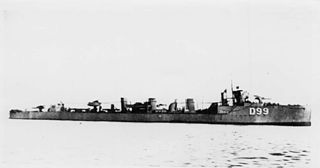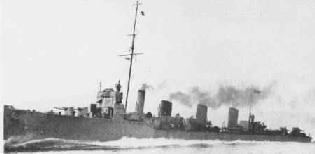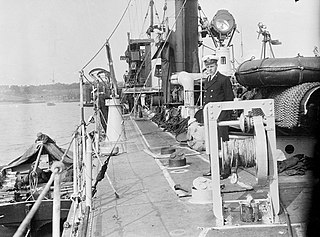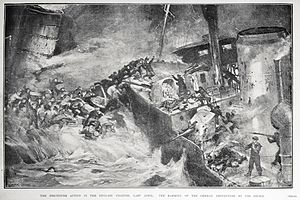
HMS Zubian was a First World War Royal Navy Tribal-class destroyer constructed from the forward end of HMS Zulu and the rear and mid sections of HMS Nubian. These two destroyers had been badly damaged in late 1916, and rather than scrapping both hulls at the height of World War I, the Admiralty ordered that they be rebuilt as the composite Zubian and put back into service. She was commissioned into the fleet in June 1917. The name Zubian is a portmanteau of the names of the original ships.

HMS Ambuscade was an Acasta-class destroyer of the Royal Navy and was launched in 1913. She served throughout the First World War, forming part of the Grand Fleet and taking part at the Battle of Jutland, serving in the Dover Patrol and spending the latter part of the war as a convoy escort. She was sold for scrapping in 1921.

HMS Swift was a unique destroyer leader designed and built for the Royal Navy prior to World War I, another product of Admiral "Jackie" Fisher's relentless quest for speed. The class was envisioned as a large ocean-going destroyer, capable of both the usual destroyer requirements and of high-speed scouting duties for a major fleet.

The Faulknor class were a class of flotilla leaders that were under construction in the United Kingdom for the Chilean Navy at the outbreak of World War I. Six ships were ordered by Chile, of which the first two were delivered to Chile before the outbreak of the war. The remaining four ships were purchased by the British, taken over and completed for the Royal Navy for wartime service. In common with Royal Navy convention, they were named after famous Royal Navy captains of the past, in this case the members of the Faulknor family.

HMS Laforey was the lead ship of her class of destroyer built for the Royal Navy. Launched a year before the First World War began, she was attached to the Dover Patrol. Laforey saw action in several engagements with German torpedo boats, including the Battle off Noordhinder Bank and the Action of 17 March 1917. Laforey was sunk in 1917 by a British mine after escorting several freighters to France. She was named for Francis Laforey, captain of HMS Spartiate at the Battle of Trafalgar in 1805.
A naval race had developed in the Aegean after the end of the Balkan Wars, with the Ottoman government ordering several ships, including two dreadnoughts, in Britain. In the event, with the outbreak of World War I, these ships, including further two scout cruisers and four destroyers, were confiscated and pressed into service with the Royal Navy. This disappointed the Ottomans, contributing to their joining the Central Powers in the Great War.

HMS Viking was a Tribal-class destroyer of the Royal Navy launched in 1909 and sold for scrap in 1919. She was the only destroyer ever to have six funnels.

The Adriatic Campaign of World War I was a naval campaign fought between the Central Powers and the Mediterranean squadrons of Great Britain, France, the Kingdom of Italy, Australia and the United States.
SMS G42 was a 1913 Type Large Torpedo Boat of the Imperial German Navy during World War I, and the 18th ship of her class.
SMS G85 was a 1913 Type Large Torpedo Boat of the Imperial German Navy during World War I, and the 40th ship of her class.

The Bombardment of Yarmouth and Lowestoft, often referred to as the Lowestoft Raid, was a naval battle fought during the First World War between the German Empire and the British Empire in the North Sea.

The Battle of the Strait of Otranto was a minor naval skirmish on 12 November 1940 during the Battle of the Mediterranean in World War II. It took place in the Strait of Otranto in the Adriatic Sea, between Italy and Albania.

HMS Broke was a Faulknor-class destroyer leader of the Royal Navy, initially built for the Chilean Navy as the Almirante Lynch-class destroyer Almirante Goñi. The outbreak of the First World War led to her being purchased by the Admiralty in August 1914 shortly after her launching, and renamed HMS Broke. All of the class were present at the Battle of Jutland on 31 May to 1 June 1916 where Broke, out of control after hits from German ships, collided with the Acasta-class destroyerHMS Sparrowhawk leading to the latter's loss. Broke saw action in several battles, and was resold to Chile after the conclusion of the war.

The Battle off Texel, also known as the Action off Texel or the Action of 17 October 1914, was a naval battle off the coast of the Dutch island of Texel during the First World War. A British squadron, comprising one light cruiser and four destroyers on a routine patrol, encountered the German 7th Half Flotilla of torpedo boats which was en route to the British coast to lay mines. The British forces attacked and the outgunned German force attempted to flee and then fought a desperate and ineffective action against the British force, which sank all four German boats.

The Battle of Dover Strait that occurred on 26–27 October 1916 was a naval battle of the First World War between Great Britain and the German Empire. Two and a half flotillas of German torpedo boats from the Flanders Flotilla launched a raid into the Dover Strait in an attempt to disrupt the Dover Barrage and destroy whatever Allied shipping could be found in the strait.

HMS Acasta was an Acasta-class destroyer of the Royal Navy, and the name ship of that class. She was built between 1911 and 1913, and was initially designated a K-class torpedo boat destroyer, having at various times the pennant numbers G40, H59 (1914) or H00 (1918). She saw extensive service during the First World War, including at the Battle of Jutland, where she was badly damaged. She was sold for breaking up in 1921.
SMS G96 was a large torpedo boat of the Imperial German Navy that was built and served during the First World War. She was the prototype ship of the 1916 Mobilisation Type torpedo boats, and was launched at Germaniawerft's Kiel shipyard on 19 September 1916, completing in December that year.

SMS V47 was a V25-class Large Torpedo Boat of the Imperial German Navy that was built and served during the First World War.
HMS Mentor was a Hawthorn Leslie M-class destroyer of the British Royal Navy. Built by the Tyneside shipbuilder Hawthorn Leslie between 1913 and 1915, Mentor served during the First World War. She formed part of the Harwich Force in the early years of the war, taking part in the Battle of Dogger Bank and then later in the English Channel as part of the Dover Patrol. She survived the war, and was sold for scrap in 1921.

HMS Matchless was a Royal Navy Admiralty M-class destroyer. Matchless was built by Swan Hunter from 1913 to 1914 and was completed in December that year. She served through the remainder of the First World War, operating in the North Sea as part of the Harwich Force in the early part of the war and later in the English Channel as part of the Dover Patrol, where she took part in both the First and Second Ostend Raids. Despite being badly damaged by a German mine in 1915 and being involved in several collisions, she survived the war, and was sold for scrap in 1921.















